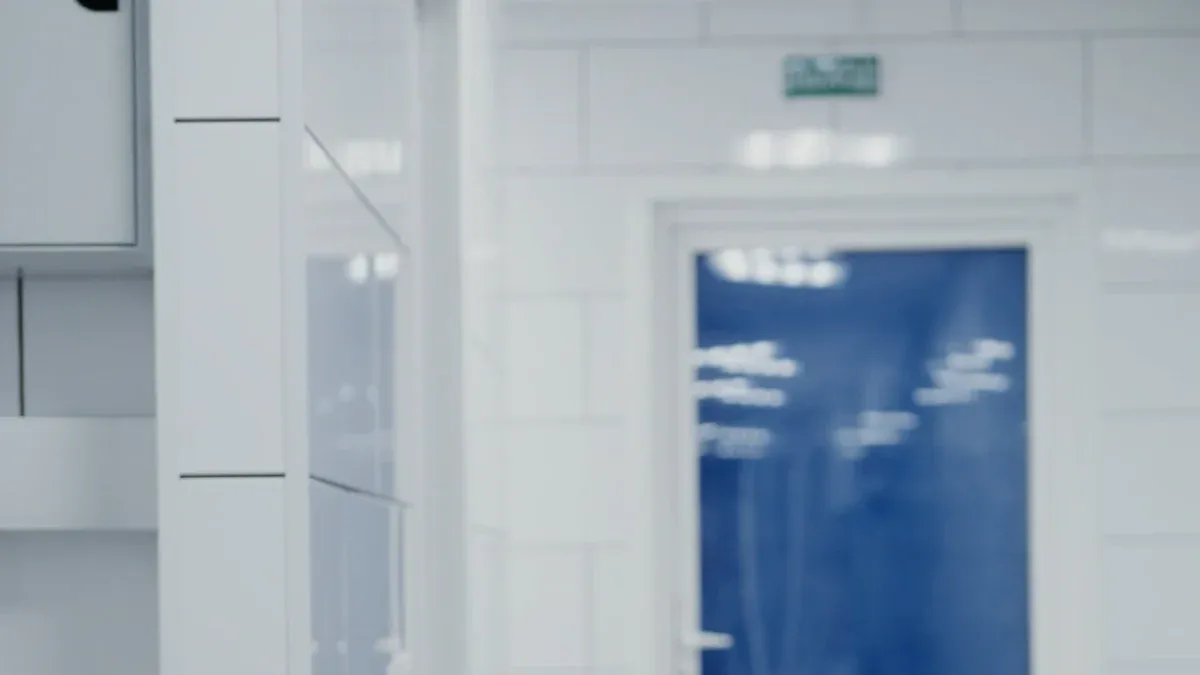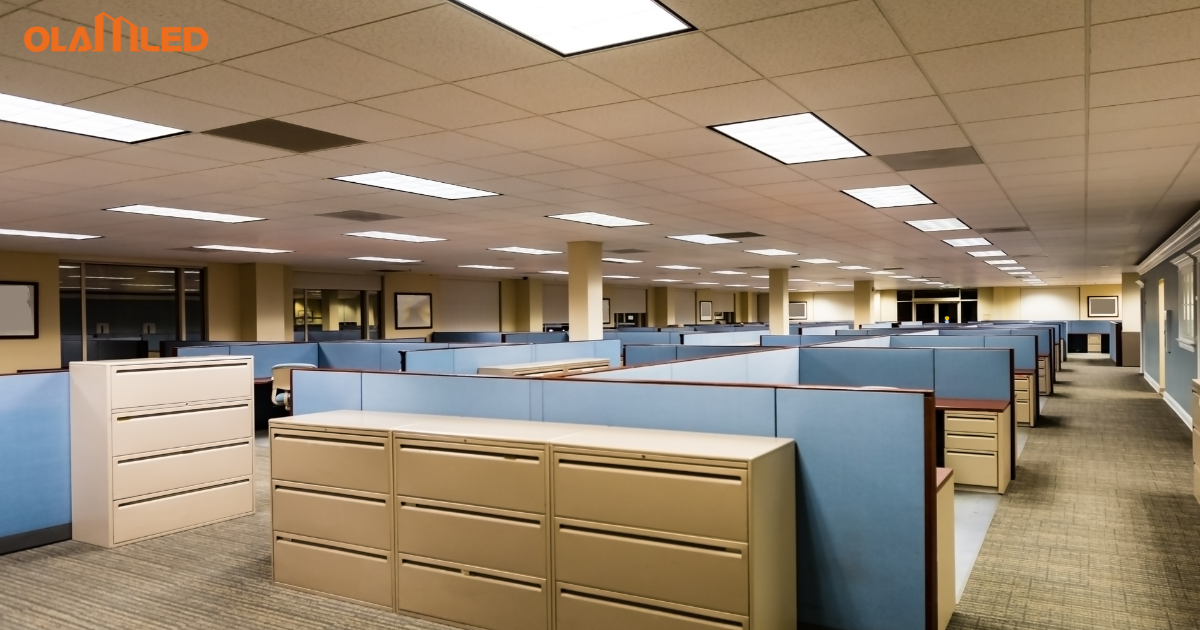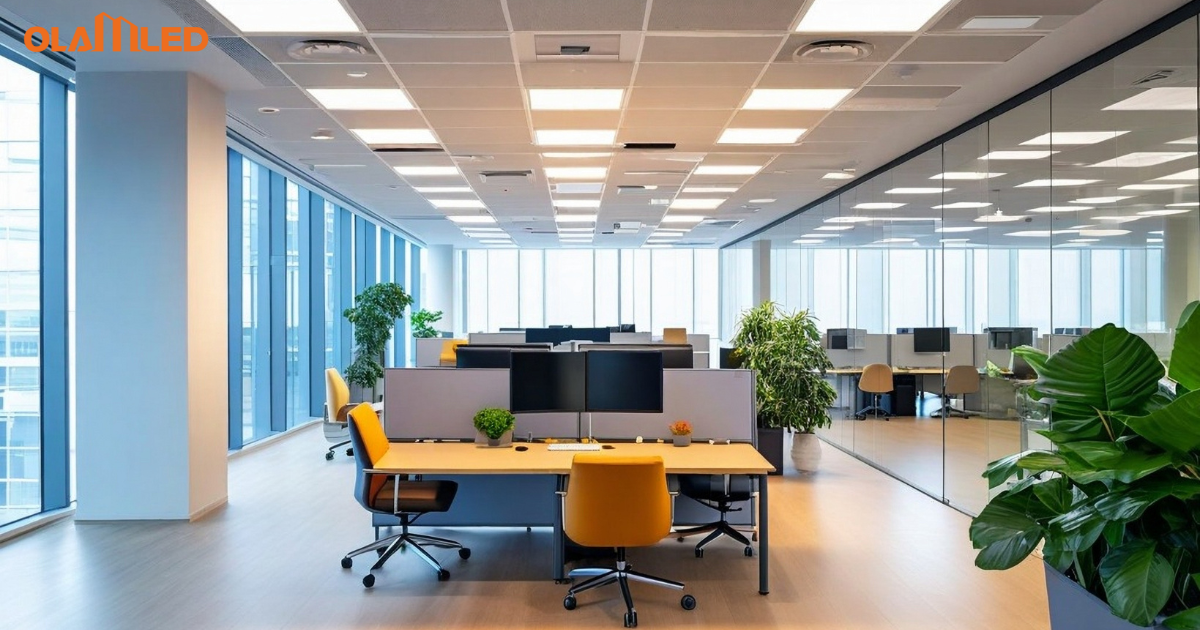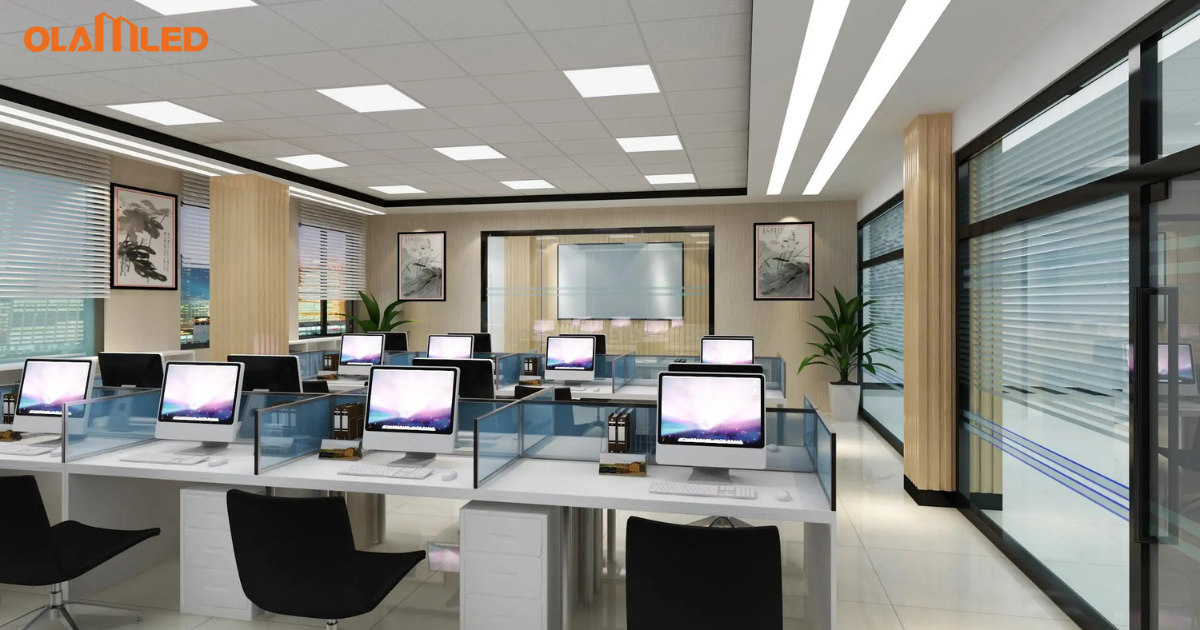
You should focus on modular cleanroom customization. This helps you follow rules and work better. Cleanroom upgrades help you meet standards. They also let you change quickly when things shift. New tools like OLAMLED cleanroom lighting keep things clean. They also help you do your job well.
Almost 35% of life science companies use modular cleanrooms. This makes work easier and helps them follow GMP rules.
About half of new modular cleanrooms have real-time monitoring. This helps them work better and spend less on repairs.
Nearly 45% of new cleanrooms are used in electronics, aerospace, and food processing. This shows they can be used in many places.
More companies are buying modular cleanrooms. They want to customize and use new technology. This helps them stay strong in controlled spaces.
Key Takeaways
Modular cleanrooms can be changed or upgraded fast. This helps companies keep up with new needs. It also helps them follow industry rules.
Picking the right ISO class is very important. It helps stop contamination. It also helps meet industry needs.
Cleanroom systems need regular checks and care. This includes HVAC and filtration. Doing this keeps the space safe and follows rules. It also lowers the chance of contamination.
Using energy-saving lights, like OLAMLED, keeps the room clean. It also lowers costs. This makes it a good choice for cleanrooms.
Planning for flexible cleanroom design is helpful. It makes it easy to grow or change the space. This helps businesses work better and grow.
Cleanroom Classification
ISO Standards
Before you build or change a cleanroom, you need to know about cleanroom classification. ISO standards help you check how clean your space is. These rules use particle counts to set levels for each industry. You must pick the right ISO class to meet cleanroom needs and keep your space free from contamination.
Here is a table that shows some common ISO classes and how they are used in the pharmaceutical and electronics industries:
ISO Class | Application in Pharmaceutical Industry |
|---|---|
Class 5 | Aseptic filling suites, biological safety cabinets |
Class 7 | Cleanroom packaging, secondary manufacturing areas |
Class 8 | Non-sterile manufacturing areas |
ISO Class | Application in Electronics Industry |
|---|---|
Class 5 | Manufacture of microelectronics and sensitive components |
Class 6 | Sensitive components that operate on the nanoscale |
Picking the right ISO class helps you control contamination. It also stops cross-contamination problems. This choice changes what your cleanroom needs and helps you reach your goals for keeping things clean.
Regulatory Needs
You have to follow rules to keep your cleanroom safe and working well. Different places have their own rules. The United States uses FDA guidelines. Europe uses EU MDR and IVDR. International rules use ISO 14644.
Region | Regulatory Body | Key Regulations |
|---|---|---|
United States | FDA | Ensures medical devices are safe and effective, covering all aspects of manufacturing, including cleanroom environments. |
Europe | EU MDR, IVDR | Sets stringent requirements for medical device manufacturers, including cleanroom conditions. |
International | ISO | ISO 14644 standards classify cleanrooms based on airborne particle concentration, essential for compliance in manufacturing. |
You must teach your staff how to work in a cleanroom. You need to check materials to lower contamination risks. You must keep equipment working and check it often. After you set up a modular cleanroom, you need to test it. This means you check particle counts and airflow. You also need to write down how you design, use, and fix your cleanroom. These steps help you follow the rules and keep your cleanroom safe.
Space and Layout
Assessing Current Space
First, look at your cleanroom space. This helps you see what is good and what needs fixing. Careful checks make sure your modular cleanroom upgrade works now and later.
Check your lighting. LED lights, like OLAMLED, help keep things clean. They make less heat and need less fixing.
Look at your panels for any damage. Fixing or changing panels keeps your cleanroom safe and sealed.
Check your walls and ceilings. Vinyl is easy to clean and does not make many particles.
Look at your floors. Good floors help keep things clean and last longer.
Know your cleanroom’s details. This stops you from spending too much or not protecting your space.
Pick good products. Strong materials and tools last longer, even in busy cleanrooms.
Think about how long it takes to get supplies. Waiting too long can slow down your work.
Plan your design. Make sure it fits your space, budget, and keeps particles low.
Make sure you can get in for repairs. Easy repairs save time and money.
Think about how big equipment will get in. Heavy or large tools need enough space to move.
Ask about ways to make your cleanroom fit your needs. Your builder should help you get what you need.
Tip: Always plan for easy repairs. This helps stop big problems and keeps your cleanroom working well.
Planning for Growth
You want your cleanroom to help your business grow. Good planning now saves time and money later. Modular layouts and flexible designs make it easy to change your space.
Best Practice | Description |
|---|---|
Use modular parts to make changes or grow your cleanroom. | |
Material Selection | Pick walls, floors, and ceilings that keep things clean. |
Make your layout flexible. This helps if your team, tools, or work changes.
Use modular walls and movable tools. These let you change your cleanroom fast.
Pick materials that are easy to clean and last long. Good choices help you follow rules as your needs change.
Good planning and the right materials help your cleanroom grow with your business. You will be ready for new problems and chances.
Modular Cleanroom Solutions
Modular Options
You have lots of choices for your cleanroom. Modular cleanrooms use parts made ahead of time. This helps you build faster and save money. You can set up a modular cleanroom in just weeks. Building a regular cleanroom can take months or years. Modular building helps you avoid long waits and high costs.
Here is a table that shows the main types of modular cleanroom solutions and their advantages:
Type | Advantages | Typical Use Cases |
|---|---|---|
Softwall Cleanrooms | Lower cost, easy to move, quick setup and reconfiguration | ISO 7 or ISO 8 environments |
Hardwall Cleanrooms | Better control of pressure and temperature, durable, stable structure | Stringent cleanroom standards |
Softwall modular cleanrooms are good for less strict places. You can move them and change how they are set up. Hardwall modular cleanrooms help you control air and temperature better. They last longer and work for tougher rules.
Modular cleanroom building lets you pick what fits best. You can add new parts or change the layout easily. This makes planning simple and saves money.
OLAMLED cleanroom lighting works well with modular cleanrooms. You can put OLAMLED lights in both softwall and hardwall cleanrooms. The lights help keep things clean and save energy. They are easy to clean and work well in tough places.
Flexibility and Adaptability
Modular cleanrooms are flexible and easy to change. You can make your cleanroom bigger as your business grows. You can move panels and parts without big changes to the building.
You can make your cleanroom bigger by adding modules.
You can change your cleanroom by moving parts.
You can make your cleanroom fit your work needs.
You can keep your cleanroom up to date with new rules.
Modular cleanrooms let you change things without stopping work. You can add new parts without taking everything apart. This helps you make more products quickly.
Many industries use modular cleanrooms for different jobs. Here is a table with examples:
Industry | Description |
|---|---|
Pharmaceutical Manufacturing | Modular cleanroom meets drug production standards and improves workflow efficiency. |
Semiconductor Fabrication | Modular cleanroom adapts quickly to changes in microchip production. |
Research Laboratory | Custom cleanroom supports sensitive experiments and reliable results. |
Food Processing Facility | Modular cleanroom keeps food safe and adapts to changing production needs. |
Biotechnology Research Facility | Modular cleanroom supports biopharmaceutical development with strict contamination control. |
Modular cleanrooms help you reach sustainability goals. Good insulation keeps temperatures steady and saves energy. This means HVAC systems do not work as hard. Making parts off-site cuts down on waste. Many materials can be recycled, which helps the planet.
Tip: Pick energy-saving lights like OLAMLED cleanroom lighting. These lights use less power and help keep your space clean and safe.
Modular cleanrooms are easy to take care of. You can swap out parts fast and keep things working. Automated systems control temperature, humidity, and airflow. This keeps your cleanroom working well and following the rules.
Modular cleanroom solutions give you control over design and building. You can meet industry rules, change when you need to, and protect your cleanroom investment.
Cleanroom Upgrades
HVAC and Filtration
You need strong HVAC and filtration systems for cleanroom upgrades. These systems help keep your space safe and follow the rules. When you plan an upgrade, focus on these steps:
Put in HEPA and ULPA filters. These filters catch almost all particles, even tiny ones. HEPA filters remove 99.97% of small particles. This is important for places like pharmaceutical and electronics companies.
Do regular audits. Internal and outside audits check how well your air filters work. You can find problems early and fix them fast.
Test how well your system works often. Measure particle counts and airflow. This helps your cleanroom meet ISO standards and stay safe.
Manage airflow with fans. Fans move enough air through the cleanroom. Good airflow keeps bad stuff out and makes your workspace safe.
Control temperature and humidity. Your HVAC system must keep both steady. This stops contamination and protects sensitive products.
Keep pressure differentials right. The right pressure keeps outside contaminants out. Positive pressure is very important for pharmaceutical and medical cleanrooms.
Plan for regular maintenance. Taking care of your systems keeps them working well and helps you follow the rules.
Tip: Always write down your HVAC and filtration upgrades. Good records help you show you follow the rules during inspections.
When you upgrade your cleanroom, you make air quality better and lower risks. Facilities that upgrade equipment often get back between 280% and 450% of what they spend over time. Upgrades are a smart way to save money and stay safe.
Airflow and Pressure
Airflow and pressure help control contamination. You must design cleanroom upgrades to keep air moving the right way. Good airflow helps keep positive pressure. This keeps bad stuff out and protects your products.
Cleanroom classifications have strict rules for air quality. You must follow ISO 14644 and GMP standards. These rules say how many particles are allowed and how often air must change.
Use advanced control systems. These systems watch and change airflow and pressure in real time. You can fix problems quickly if something changes.
Plan your installation carefully. Put vents and filters where they work best. This makes sure airflow is even and every part of your cleanroom stays safe.
Test your pressure differentials. Regular checks help you find leaks or weak spots. Fixing these problems quickly keeps your upgrades working well.
Train your staff. Everyone should know how to use and watch control systems. This helps you find problems early and keep your cleanroom running smoothly.
Good airflow and pressure control protect your products and your business. You can stop costly contamination and meet industry rules. When you plan cleanroom upgrades, focus on these systems for the best results.
Note: Good airflow and pressure control also help save energy. This lowers costs and helps you reach sustainability goals.
Cleanroom upgrades that focus on HVAC, filtration, airflow, and pressure give you a safer workspace. You can meet rules, protect your products, and get a good return on your investment. Careful planning and expert setup make sure your upgrades last a long time.
Materials and Surfaces

Walls and Ceilings
Strong walls and ceilings keep your cleanroom safe. The right materials stop leaks and block dust. Surfaces must handle strong cleaning chemicals often. Many companies use panels for modular construction. This makes upgrades and changes easier.
Here is a table showing common materials and their features:
Material Type | Features |
|---|---|
Sandwich Panels | Lightweight, strong, good thermal insulation |
PUF (Polyurethane Foam) | Excellent thermal insulation, lightweight |
PIR (Polyisocyanurate) | Superior fire resistance compared to PUF |
Rockwool | Excellent fire and sound insulation, used in pharma applications |
Stainless Steel Panels | Corrosion-resistant, ideal for sterile environments |
Aluminum Honeycomb Panels | Lightweight and rigid, suitable for strength and stability |
High-Pressure Laminates (HPL) | Durable, scratch-resistant, cost-effective for less critical areas |
You can pick FRP panels, rockwool panels, aluminum honeycomb panels, or stainless steel. FRP panels resist chemicals but break if hit hard. Rockwool panels insulate well but are heavy. Aluminum honeycomb panels are light but cost more money. Stainless steel is very clean but costs a lot.
Good walls and ceilings help you:
Stop leaks and contamination.
Handle cleaning with disinfectants.
Allow modular upgrades.
Meet fire and anti-static rules.
NUDO’s FRP wall and ceiling systems are tough and resist water. These features help keep your cleanroom clean.
Tip: Pick panels that fit your needs for hygiene, fire safety, and easy cleaning.
Flooring Choices
Your flooring should help keep your cleanroom safe. You need a surface that does not trap dust. It must stand up to strong chemicals. Many places use seamless epoxy resin flooring. It resists chemicals and lasts a long time. Vinyl flooring is easy to put in and stops static, but it does not last as long as epoxy. Rubber flooring is not slippery and makes less noise, but you must care for it more.
Other choices are antistatic and conductive flooring. These stop static electricity in sensitive areas. Ceramic or porcelain tile floors are tough and resist chemicals. But seams can trap dust and make cleaning harder.
Flooring options for cleanrooms:
Epoxy resin flooring: seamless, chemical-resistant, durable.
Vinyl flooring: easy to install, antistatic, cost-effective.
Rubber flooring: slip-resistant, quiet, needs more maintenance.
Antistatic/conductive flooring: prevents electrostatic discharge.
Ceramic/porcelain tile: durable, chemical-resistant, seams need extra cleaning.
Note: Pick flooring that matches your cleaning and safety needs. Seamless floors are easier to clean and help keep your cleanroom in good shape.
Cleanroom Lighting Solutions
OLAMLED Lighting Features
You need special cleanroom lighting to follow strict rules. OLAMLED cleanroom lighting has advanced features. These features help you work safely and follow the rules. The lights have sealed construction. This keeps out dust, dirt, and germs. The high IP65 rating protects against water and dust. Cleaning is easy and safe with these lights.
Here is a table that shows what makes OLAMLED cleanroom lighting different:
| Feature | Description |
|---|---|
| Sealed Construction | Stops dust, dirt, and germs from getting inside the fixture |
| High IP Rating | IP65 or higher protects places that need lots of cleaning |
| Material Durability | Uses stainless steel or powder-coated finishes for easy cleaning |
| Uniform Illumination | Gives even light with no shadows |
| High Color Rendering | CRI>90 shows true colors and helps you see better |
The fixtures are easy to clean and do not shed particles. The lights use strong materials like aluminum and stainless steel. Welded or sealed housing keeps dust out. OLAMLED cleanroom lighting lasts longer than regular bulbs. You save time and money because you do not replace them often.
Tip: Pick cleanroom lighting with anti-bacterial coatings. This helps stop germs from growing on surfaces.
Lighting Placement
You must put your lights in the right places. This keeps your cleanroom safe and helps you work well. Good lighting placement gives even coverage. It stops shadows from hiding dirt or problems. You need uniform lighting in all work areas.
Put lights so every surface and workstation gets light.
Use enough fixtures to stop dark spots.
Test your lighting system under normal conditions. Check brightness and energy use.
Uniform lighting helps you see clearly. It also keeps your cleanroom clean. You meet ISO standards when you plan your lighting layout well.
Making sure your lights cover everything and remove shadows helps you see better and clean better.
You can trust OLAMLED cleanroom lighting to work well. The lights give you the right brightness. They lower glare and help you keep your cleanroom in good shape.
Furniture and Equipment
Cleanroom Furniture
You need furniture that keeps your cleanroom clean and comfy. Each piece should help you follow hygiene rules and make work easier. Pick furniture that does not drop particles and is simple to wipe down. This helps keep your space safe and free from germs.
Here is a table that lists good furniture and what makes them useful:
| Furniture Type | Key Features |
|---|---|
| Cleanroom Chairs | Prevent material shedding and provide comfort for extended sitting |
| Cleanroom Tables | Durable, conductive, and made from stainless steel or high-grade plastic |
| Gowning Benches & Racks | Securely hold garments and assist in organized dressing procedures |
| Drawers and Counters | Easy to operate, handle-free design minimizes contamination risks |
| Anti-Fatigue Mats | Non-shedding, easy to clean, and cushioned for standing comfort |
Workbenches that fit your body help you move less and keep the air clean.
Chairs you can change help everyone sit up straight.
Anti-fatigue mats help people who stand a lot and are easy to clean.
All furniture must be very clean. Pick things that do not get hurt by chemicals and are fast to clean. This keeps your cleanroom safe and helps you work well.
Tip: Choose furniture with flat surfaces and few seams. This makes cleaning simple and lowers the chance of germs.
Equipment Integration
You need to plan how equipment fits in so work goes smoothly and follows the rules. Modular cleanroom systems help you plan from start to finish. This makes sure you follow all the rules and work well.
| Aspect | Description |
|---|---|
| Comprehensive Planning | Provides end-to-end support to ensure compliance and operational efficiency |
| Streamlined Installation | Offers quick, non-disruptive setup to minimize downtime |
| Ongoing Maintenance | Ensures long-term reliability and continuous regulatory compliance |
Follow GMP rules to keep products safe and make things right.
Modular designs let you change things fast when rules change or you grow.
Always following the rules helps you avoid problems and save money.
Modular cleanroom systems follow GMP rules from around the world. You can change your setup when rules change and help your team try new things. Good planning and care keep your equipment working and your cleanroom safe.
Updating Your Cleanroom
Steps for Upgrades
You need a good plan to update your cleanroom. Take each step one at a time. This helps you follow the rules and keep your work easy. Here is a simple way to upgrade your cleanroom:
Look at your cleanroom now. Check if anything is broken or not working.
Plan a new layout. Add things that stop contamination and help you work faster.
Make your HVAC and air filters better. Make sure they meet new cleanroom rules.
Put in new tools and machines. Add airlocks, gowning rooms, and pass-throughs for better control.
Use modular building. This saves time and keeps your space clean while you build.
Test and check everything. Make sure your cleanroom meets ISO, GMP, or other rules.
Modular cleanrooms let you upgrade fast. You can keep things clean while you work. OLAMLED cleanroom lighting helps you follow the rules and work well. The lights are sealed, show colors well, and are easy to clean. These things help you stay clean during every step of your upgrade.
Tip: Always test and check after each upgrade. This makes sure your cleanroom is safe and works right.
Maintenance and Validation
You must keep your cleanroom working well after upgrades. Maintenance and validation help you stay safe and follow the rules. Do these steps for the best results:
Make a plan for validation. Set clear goals and what counts as a pass.
Check for risks. Find and fix anything that could hurt safety or quality.
Check that all equipment is set up right. Make sure everything works as it should.
Test your systems. Make sure they do what you want them to do.
Run tests in real life. See if everything works the same every time.
Write down every step. Keep good records for checks and inspections.
Every day, watch pressure, check temperature and humidity, and clean surfaces. Each week, do deeper cleaning and check your equipment. Every few months, look at logs, check lights, and make sure sensors work right. Once a year, do a full check, test HEPA filters, and measure airflow.
OLAMLED cleanroom lighting makes cleaning easier. The sealed lights and anti-bacterial coating help you keep things clean. Good lighting helps you test and check your cleanroom, so you can follow the rules all year.
Note: Regular care and good checks protect your cleanroom. This keeps your cleanroom ready for anything.
Expert Support
Professional Guidance
You need help from experts when you plan a cleanroom. Getting advice from professionals helps you avoid mistakes. It also helps you reach your goals faster. In-house installers know the designs and equipment very well. They keep the quality high at every step. When designers and installers work together, you get better results. This teamwork lowers the chance of errors. In-house teams train often. They learn what you need and keep standards strong. You build good relationships with cleanroom partners. These connections help you even after your cleanroom is set up.
In-house installers have lots of experience with cleanroom designs and equipment.
Designers and installers work together, so communication is better.
In-house teams train often to keep quality the same.
Long-term partnerships give you help after your project is done.
You should find consultants with the right skills. The table below shows what is most important:
| Qualification Type | Importance |
|---|---|
| Specialized Experience | Enables effective handling of complex biologics and advanced therapy manufacturing processes |
| Regulatory Knowledge | Ensures compliance with FDA, EMA, and WHO standards |
| Technical Capability | Supports design, testing, and validation to meet strict cleanroom specifications |
| Adaptability | Allows customization for specialized or unique biological processes |
Custom Engineering
Custom engineering helps your cleanroom project succeed. You get solutions that fit your needs and meet all standards. Engineers design systems that work fast and keep downtime low. You can make your cleanroom bigger or change it as your business grows. Turnkey solutions make everything simple from start to finish.
| Aspect | Contribution to Success |
|---|---|
| Compliance | Ensures full adherence to industry and regulatory standards |
| Rapid Installation | Enables quick setup to get your cleanroom operational faster |
| Scalability and Flexibility | Allows seamless expansion or modification as project needs evolve |
| Engineering Expertise | Optimizes system performance and minimizes equipment downtime |
| Turnkey Solutions | Delivers complete, end-to-end project management from design to handover |
You feel calm when you trust experts with your cleanroom. They help you follow the rules, work well, and get ready for future growth.
When you plan modular cleanroom customization, remember these steps. First, make your cleanroom flexible. This way, you can change or grow it later. Next, pick systems that fit your needs and look nice. Also, use finishes that are smooth and easy to clean. These finishes help stop germs from spreading.
| Feature | Benefit |
|---|---|
| Cleanroom Lighting | Maintains hygiene standards and ensures regulatory compliance |
| Modular Design | Allows easy upgrades, customization, and future scalability |
| Expert Support | Reduces errors, improves efficiency, and saves valuable time |
Work with people who know about cleanroom problems. New tools like OLAMLED cleanroom lighting help you follow tough rules. They also keep your workspace safe. Ask experts for help so your cleanroom is ready for what comes next.
FAQ
What is modular cleanroom customization?
You can change your cleanroom by moving or adding walls. You can also add new lights or equipment. Modular customization helps you upgrade quickly. It keeps your workspace clean and safe.
How do you choose the right cleanroom lighting?
Pick lights that are sealed and do not let in dust. Choose lights that show colors well and do not hurt your eyes. OLAMLED cleanroom lighting meets tough hygiene rules. These lights are easy to clean.
Why is regular validation important for cleanrooms?
You must check your cleanroom often to follow the rules. Regular checks help you find problems before they get worse. This keeps your products safe from contamination.
Can you expand a modular cleanroom easily?
You can add more parts or change the layout fast. You do not have to stop working to make your cleanroom bigger. Modular systems help your cleanroom grow as your business changes.
What materials work best for cleanroom surfaces?
Use stainless steel, epoxy resin, or vinyl for surfaces. These materials do not get damaged by chemicals. They are easy to clean and help keep your cleanroom safe.



